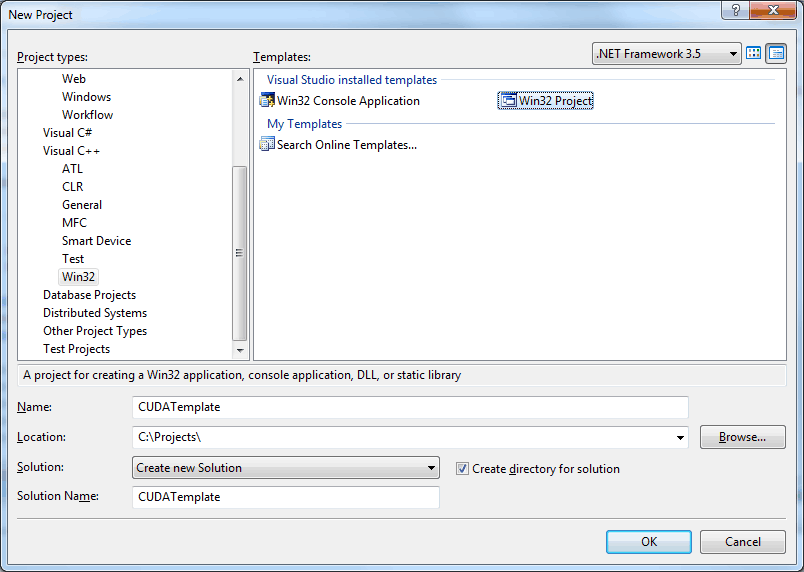

- Visual studio win32 application wizard how to#
- Visual studio win32 application wizard code#
- Visual studio win32 application wizard windows#
The system provides a number of message commands, such as WM_PAINT for receiving drawing messages and WM_LBUTTONDOWN for receiving mouse click messages. The WndProc function handles messages received by the application.įirst, you need to determine the type of message you receive and then do different processing, which requires the use of switch statements. TranslateMessage(&msg) //Translation messageĭispatchMessage(&msg) //Dispatch message When an application receives a message, the loop schedules the message to the WndProc function for processing. Add a message loop to listen for messages sent by the operating system. The message loop is similar to the following code: The WndProc function is used to process received messages, as we will see below. When an application receives a message, the loop schedules the message to the WndProc function.
Visual studio win32 application wizard code#
See the code at the end of the article for details.Īdd a message loop to listen for messages sent by the operating system.
Visual studio win32 application wizard windows#
Now you need to create windows using the CreateWindow functionĭisplay windows using Show Window functions RegisterClassEx functions are used and window class structures are passed as parameters. Windows classes have been created and must be registered. We need to know that this structure contains information about windows, such as application icons, window background color, the name displayed in the title bar, the name of window procedure function, and so on. Wcex.hIconSm = LoadIcon(wcex.hInstance, MAKEINTRESOURCE(IDI_APPLICATION)) įor beginners, we do not need to over-entangle the details of the code, temporarily from the macro control.

Wcex.hbrBackground = (HBRUSH)(COLOR_WINDOW+1) Wcex.hCursor = LoadCursor(NULL, IDC_ARROW) Wcex.hIcon = LoadIcon(hInstance, MAKEINTRESOURCE(IDI_APPLICATION)) For example, the application icon, the background color of the window, the name displayed in the title bar, the name of the window procedure function, and so on. This structure contains information about windows Create a window class structure of type WNDCLASSEX.
Visual studio win32 application wizard how to#
How to create a window class structure of WNDCLASSEX type? The following code demonstrates the definition of a typical window class structure, WNDCLASSEX: Int WINAPI WinMain(HINSTANCE hInstance, HINSTANCE hPrevInstance, LPSTR lpCmdLine, int nCmdShow) The logic that needs to be implemented inside the WinMain function is basically unchanged, namely:Ĭreate a window class structure WNDCLASSEX that describes form information WinMain is equivalent to an entry function and has a fixed grammar: Just as every C/C++ console application must have a main function at its starting point, every Win32-based application must also have a WinMain function.


To meet our needs, add the following references (the first two are required): Our application needs to use many existing definitions to accomplish the required functionality. In the Name box, type a file name, such as GT_HelloWorldWin32.cpp. In the Add New Items dialog box, select "C++ File (.cpp)". HelloApp project, then click Add and New Items in turn. Under Additional Options, select Empty Item. Under Application Type on the Application Settings page, select Windows Applications. On the welcome page of Win32 Application Wizard, click Next. In the Name box, type a project name, such as HelloApp. In the middle pane, select Win32 Project. In the left pane of the New Project dialog box, click Installed Template and Visual C++, and then select Win32. On the file menu, click New, and then click Project.Ģ. Next, let's step by step introduce the general framework where the code is involved, and the complete code will be given at the end of the article. Getting to the point, this article discusses how to use Visual Studio to generate the simplest C form application and display Hello to the user~ If you're just starting out, this article must be very suitable for you. Here I will record the learning process from a zero-based perspective. Recently, I just started to learn C/C++ to develop Windows applications. How to create the simplest Windows desktop application (C++)


 0 kommentar(er)
0 kommentar(er)
